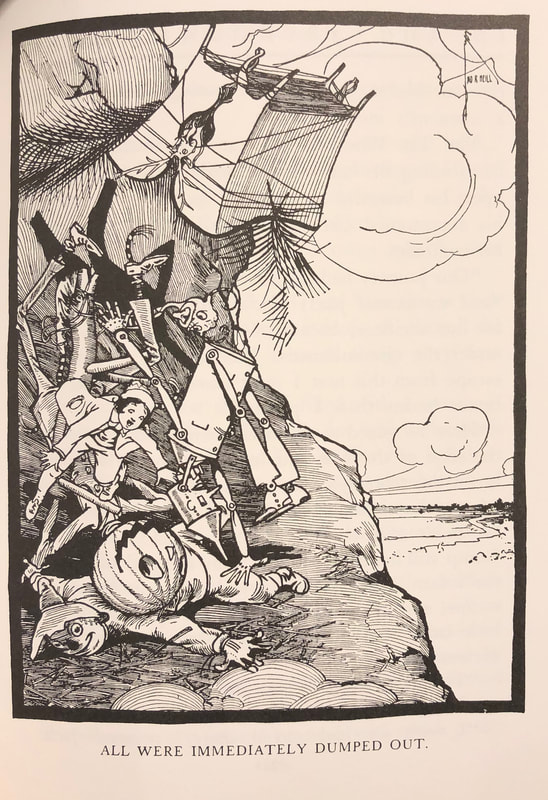|
The road to tracing the existing original artwork created by John R. Neill for the Oz series is more often than not a scavenger hunt. It starts with a lead, which leads to a lot of inquiry work, and occasionally - just occasionally - results in an undiscovered treasure. Such was the case of a recent search in the vaults of Columbia University. Now, Neill, himself, retained none of the illustrations he drew for the Oz books. They were expressly the property of the publisher, Reilly & Britton (later Reilly & Lee, and later still Regnery and then Contemporary Books). By the time Contemporary sold the last of its Oz archives in the early 1980s, but a tiny fraction of the original artwork was left. It's largely believed most of the artwork was purged by the publisher in the early 1960s, and so it's always intriguing to learn of a collection in private or public hands that pre-dates that time period.  The first major exposition of L. Frank Baum's work was in 1956 at Columbia University, and it was the brainchild of Roland Baughman, who was the Head of the Department of Special Collections at Columbia, and a fervent collector of L. Frank Baum and Oziana himself. The exhibit contained books and a few pieces of original artwork by Denslow and Neill that Columbia purchased specifically for the exhibition. In the decades since the exhibition, the drawings have been housed with the effects of Roland Baughman's papers (gifted to Columbia upon his death in 1961) and as is often the case with Neill's art, misidentified in the school's records. Thanks to the efforts of the dedicated staff at the Butler Library, the works were traced and brought out of the vaults, for what may have been their first viewing in a very long time. Still encased in the inexpensive black wooden frames they were put in for the 1956 exhibit (and covered in decades worth of dust), the three illustrations from THE MARVELOUS LAND OF OZ nevertheless remain- well, absolutely marvelous. The first drawing, featuring Tip and Jack Pumpkinhead sleeping on the side of a hill, while the Saw Horse watches nearby corresponds to the colored plate on page 56 of the published volume. Neill, incidentally, with the exception of his watercolors for THE EMERALD CITY OF OZ and DOROTHY AND THE WIZARD IN OZ did all his works in pen and ink on Bristol Board, with the colorization happening later (and by other hands) in the printing process. This work is especially notable in it's homages to traditional Denslow flourishes; in particular, the outline of a larger than life sun overhead may have been Neill's attempts to mirror the style of his highly successful predecessor on the Oz series. The second sketch of Tip, Jack and the Sawhorse crossing a river is intriguing in that it is the only original art for a half-page sized illustration that is presently known to have survived from MARVELOUS LAND. A fun surprise is seeing that despite the rather small size of the illustration in the published book, Neill took an entire full-sized board to craft the drawing! Neil apparently made some changes to the design of this illustration as there is an 'insert' piece of paper pasted on the middle of the board and drawn over. Both illustration boards unfortunately have major damage to them; large cracks cross the entire length of the image. Interestingly, this damage corresponds to a similar split on another illustration board from LAND sold at auction in recent years, and would indicate the damage may have been sustained in the storing of the works at the publishing house. How the works came to leave Reilly and Britton remains a mystery... The third illustration from MARVELOUS LAND is on a slightly smaller board (and one with a slightly different sheen). Though familiar, there was something instantly 'off' about the image, but it took a moment to realize what it was. When compared to the finished illustration in the published book, something is missing. Can you see what it is? Ah yes! It's our old friend, H.M. Wogglebug T.E., MIA from the pen and ink illustration! But what could that mean? Is this illustration at Columbia a copy? A drawing for an abridgment of the story in which the Wogglebug doesn't appear? Or was this a preliminary drawing done by Neill that perhaps was rejected upon the realization that a major character from the episode was missing?
An early (and persistent criticism) L. Frank Baum had of John R. Neill's work was that he failed to astutely observe the details in his narration. While we may never know what exactly is the story behind it, it seems likely that this was (perhaps the first) instance in which Baum finger wagged his new illustrator for not closely reading his story.
0 Comments
Leave a Reply. |
AuthorBrady Schwind is a writer, director, and Oz Enthusiast on a mission to definitively catalogue the existing original artwork from the famed "Famous Forty" Oz books. Archives
November 2023
Categories |





 RSS Feed
RSS Feed
